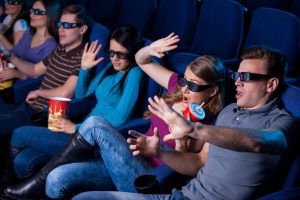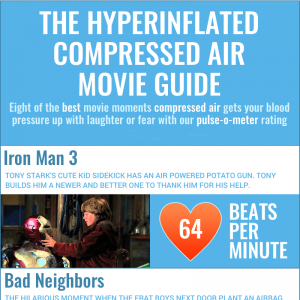

5D Experiences: Theatre sizes vary from seating. The air compressor is installed in a room behind the small theatre, with small tubes run throughout cinema seating. The air is then ‘sprayed’ at audience members to shock and/or replicate scenes in the film shown, for example, snakes hissing, or long grass blowing in the wind.
Reciprocating air compressors with pre-filter and dryer are generally used, with compressor capacities varying from 10 horse power for a 10-seater theatre to 20 horse power (or more!) for higher seat capacities

Special Effects: Compressed air even helps to create the special effects in movies! When a hero explodes across the screen, they may have been launched with a compressed air cannon! Although these days hero explosions are mostly managed through CGI and post-production effects.

Sound Effects: Vegetables are chopped, watermelons are smashed, coconut shells are clacked keys are scraped and jangled: all in the service of creating sounds that don’t exist or couldn’t be recorded live. Compressed air is used in the making of most sound effects. In X2, the 2003 X-Men movie featuring Hugh Jackman as Wolverine and Patrick Stewart as Professor X, compressed air – alongside a can of dog food – was used by Foley artists to create the sound of character Nightcrawlers teleporting noise.
The Hyper-Inflated Compressed Air Movie Guide
The creators of the infographic looked for both funny and frightening scenes in movies and decided to link compressed air and blood pressure, and then rated each scene with the pulse-o-meter.
Ref:http://www.infographicpost.com/the-hyper-inflated-compressed-air-movie-guide/2017/06/28


